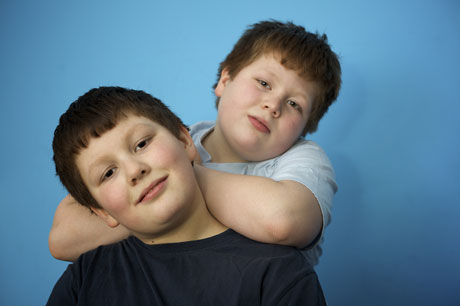 The most noticeable thing about looking at pictures from the ’80s—aside from identifying fashion that has made a comeback on Capitol Hill hipsters—is what you don’t see. Large people are noticeably absent, and extremely large people nearly nonexistent.
The most noticeable thing about looking at pictures from the ’80s—aside from identifying fashion that has made a comeback on Capitol Hill hipsters—is what you don’t see. Large people are noticeably absent, and extremely large people nearly nonexistent.
It isn’t just the rose-colored glasses of nostalgia at play. We really are much, much heavier than we were 30–40 years ago: More than one-third of adult Americans are now considered obese, and so are 17 percent of children ages 2–19.
The real question is, how did this happen? How did we collectively swell our bodies and those of our kids — and with that expansion, our rates of asthma, hypertension and diabetes?
While it’s tempting to push the problem of childhood obesity onto the parents and decry the lack of personal responsibility when it comes to health choices, it’s clear the rate of childhood obesity nationwide didn’t triple over the last 30 years just by parents growing lazy. Something much larger is at play.
The culture
“American culture has changed dramatically since the 1960s,” says Dr. Lenna Liu, a pediatrician at the Odessa Brown Children’s Clinic and the medical head of the obesity program at Seattle Children’s Hospital. “Our portions are bigger, we’re eating more processed and calorically dense foods, and we lead a more sedentary lifestyle. This combination has created a perfect storm.”
Today’s kids spend more time in front of screens and less time being active, Liu says. “Parents used to let their kids roam the neighborhood. Now those children are inside, glued to screens.” According to the Kaiser Family Foundation, kids younger than the age of 6 watch an average of two hours of screen media a day.
She also feels that the 24-hour news cycle — filled with frightening reports — has made us more fearful about letting our kids play outside.
Liu is quick to point to cultural norms rather than individual parenting choices when it comes to issues of health and diet. Often, kids’ options are dictated by their environment: If the places where kids live, go to school and play aren’t offering healthy choices, being healthy becomes an uphill battle. “People talk about obesity like it’s a personal choice,” says Liu, “but right now you have to be deliberate to make healthy choices. It’s actually easier to find less healthy food and be less active. That needs to change.”
Jennifer Trott, associate director of the Seattle-based advocacy group Childhood Obesity Prevention Coalition, agrees. “People usually point to food and individual choice and the parents when it comes to childhood obesity, but even the best parents have a lot to work against,” she says. “Their kids go to school and the store and entertainment venues, where they’re marketed unhealthy food.”
The neighborhood
While Trott says the obesity epidemic has come about as a result of many factors, she also blames traffic flow and neighborhood design. Trott says the emphasis on driving, rather than walking or biking, has become increasingly prevalent, often because of the way our communities are planned. Many communities don’t have sidewalks or safe routes to parks and community centers that don’t involve getting in a car.
The Childhood Obesity Prevention Coalition lobbied last year for a bill to make health a factor in all Washington state transportation decisions — from the impact of traffic on asthma to activity access. “People need to remember that everything we do has an impact,” says Trott. “Health is going to be affected when we take out that bike lane or add arterials through a neighborhood.”
Even in urban communities with the physical infrastructure to support walking, a lack of access to healthy foods and safe outdoor spaces contribute to the high rates of childhood obesity. One in three low-income preschool children are now overweight or obese, with Hispanic, Native American and Native Alaskan children shouldering the highest rates of obesity, according to the Centers for Disease Control and Prevention.
Many poorer communities don’t have access to fresh fruit and vegetables, and residents are left to decide between convenience stores and fast-food restaurants, says Trott. In addition, low-income children may have limited green space at their disposal, and safety concerns may limit their ability to take advantage of the play areas that are available.
The solution
With so many cultural factors seemingly conspiring to doom us to obesity, it’s tempting to throw up our hands and admit defeat. Liu claims, however, that there are many things families can do to help overweight and obese children.
“It’s important to make it a family issue,” says Liu. “Don’t pick out one person in the family who needs to be healthier. The more parents role-model healthy behaviors, the better it is for their kids.”
Liu encourages families to eat together and be more active as a family — walk or ride bikes together, play in the park, or plan vacations with a physical component. “Normalize physical activity and teach healthy behaviors from the time they’re little,” she says.
Liu recommends cutting out fast food and eating more fruits and vegetables — “the basics,” says Liu — and making sure kids are getting adequate sleep. “We now know the impact sleep has on obesity,” says Liu, who suggests getting kids to bed earlier and turning off the TV and computer screens at least an hour before bed.
Liu and Trott both emphasize the need to cut down on sweetened beverages, including soda, energy drinks, sweetened ice tea and even juice. Trott says sugary drinks are one of the leading causes of obesity today and an easy target for parents in making a significant impact on their child’s health.
“If your kids are already drinking sugar-sweetened beverages, don’t cut them completely — it will only make your kids want them more,” says Liu. She recommends giving children water or milk instead. “Let’s return to soda being an occasional treat,” she says.
Trott suggests parents advocate for macro solutions, such as making healthier foods and beverages accessible in places where kids learn and play, decreasing speed limits on non-arterial streets, adding sidewalks and bike lanes, increasing joint-use community space (such as using school playgrounds as community play spaces after the school day) and organizing “walking school buses” of kids chaperoned by an adult to school.
“The jury is out on the one ‘solution’ to childhood obesity,” says Trott. “We do know it will take a variety of strategies to get there.”
Cedar Burnett is a freelance writer and the mother of a fascinating 3-year-old. More at cedarburnett.com.
How to help your kids maintain a healthy weight
- Limit screen time (television, computers, phones) to one to two hours a day.
- Make sure your kids get at least one hour a day of physical activity. Some of the best activities for kids 4–7 years of age are running, gymnastics, playing on a jungle gym and climbing trees.
- Give your kids water or milk and strictly limit sugar-sweetened beverages. When serving juice, water it down.
- Limit snacks. Encourage eating as a family during meal times.
- Incorporate physical activity into your time with your children: Walk or bike to the store with your kids. When you’ve driven somewhere, park as far away as possible and walk. Take the stairs instead of using the elevator.
- Make sure your children are getting enough sleep.
- Model healthy behaviors. Your kids watch you for cues to healthy or unhealthy lifestyle choices.












